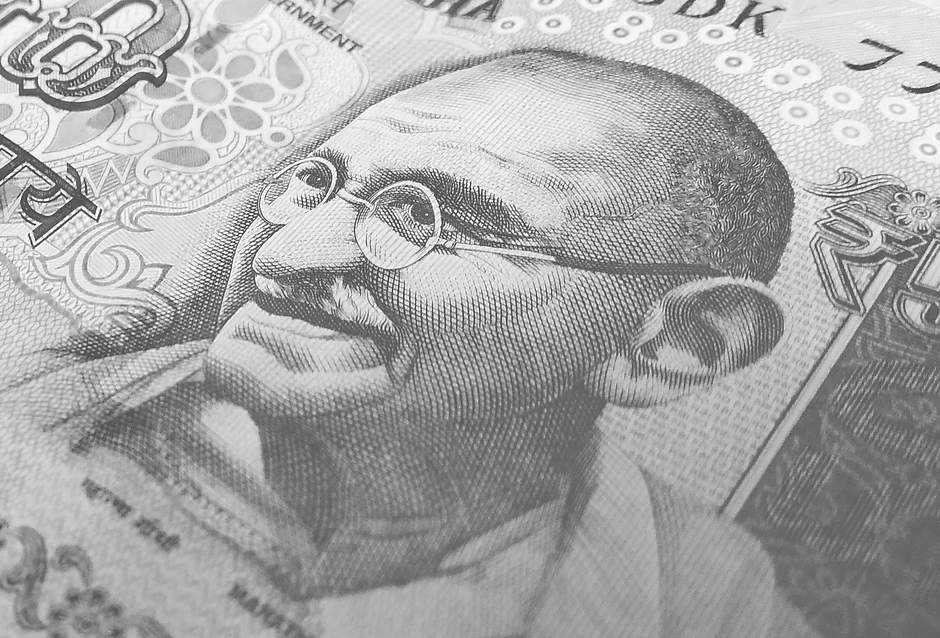Indian Rupee gains traction from RBI’s late intervention, ongoing Middle East conflict, higher oil prices eyed
- Indian Rupee gains ground amid global uncertainty and risk-off mood.
- The escalating geopolitical tension between Israel-Hamas, higher crude oil prices might cap the upside of the Indian Rupee.
- The Reserve Bank of India's October bulletin showed economy is anticipated to further strengthen through the rest of the year.

The Indian Rupee (INR) trades strongly against the US Dollar (USD) on Friday. The stronger note of INR is bolstered by the Reserve Bank of India (RBI)'s potential aggressive intervention late in the previous session. The Dollar sales from the Reserve Bank of India (RBI) likely counterbalanced the impact of the risk aversion prompted by the escalating conflict in the Middle East. Moreover, a rise in US Treasury yields and higher crude oil prices might also have contributed to the risk-off environment and cap the upside of the Indian Rupee.
Growth in the Indian economy is anticipated to gain momentum through the rest of the year, especially from festival spending, the Reserve Bank of India's October bulletin showed Thursday. Traders will keep an eye on India’s FX Reserve and RBI Meeting Minutes, due later on Friday. Furthermore, traders will take more cues from the Fed officials' speech, including Logan, Mester, and Harker in the absence of top-tier economic data releases from the US.
Daily Digest Market Movers: Indian Rupee gains traction amid the uncertainty
- RBI Chief Shaktikanta Das stated that the central bank does intervene in the forex market, but only to prevent excessive volatility of the Indian Rupee.
- RBI Chief Shaktikanta Das emphasized that the central bank is keeping a close eye on the evolving inflation dynamic amid the uncertainty on food inflation.
- India's Finance Minister will monitor the impact of ongoing tensions in the Middle East on the supply chain.
- The Indian government is uneasy with the settlement currency, yuan, as Indian refiners have used yuan to pay for some oil from Russian sellers.
- The RBI's October bulletin showed growth is expected to gain momentum through the rest of the year.
- In August, the Reserve Bank of India (RBI) sold a net $3.86 billion in the spot foreign exchange market.
- The US Initial Jobless Claims dropped to 198K for the week ending October 14, the lowest level since January 2023.
- Existing home sales fell 2.0% MoM in September, the lowest level since October 2010.
- Fed Chair Jerome Powell signaled a desire to pause rate hikes and will watch how economic data develop in the coming months.
- The US Building Permits for September dropped to 1.475 million in September, above the estimated 1.45 million.
- The US Housing Starts for the same period climbed to 1.35 million, falling short of the market consensus of 1.38 million.
- The Federal Reserve’s Beige Book update showed the US economic outlook had "little to no change" between September and early October.
- US Retail Sales grew 0.7% MoM in September, beating the market estimation of 0.3%. Retail Sales Control Group rose by 0.6% MoM from 0.2% in the previous reading.
- The Indian Wholesale Price Index (WPI) arrived at -0.26% YoY in September from the previous reading of 0.52%, below the market expectation of 0.50%.
Technical Analysis: Indian Rupee holds positive ground above the 83.00 area
Indian Rupee remains firm against the US Dollar (USD) this week. The USD/INR pair trades within a narrow range of 83.15-83.30 and finds support above the 83.00 psychological round mark. Any follow-through selling below the latter could see a drop to 82.82 (low of September 12). On the flip side, a high of October 12 at 83.40 acts as an immediate resistance level for the pair. The next barrier to watch is the all-time highs around 83.45, followed by a psychological figure at 84.00. The USD/INR pair holds above the 100- and 200-day Exponential Moving Averages (EMA) on the daily chart, which hints that further upside looks favorable.
US Dollar price in the last 7 days
The table below shows the percentage change of US Dollar (USD) against listed major currencies in the last 7 days. US Dollar was the weakest against the Swiss Franc.
| USD | EUR | GBP | CAD | AUD | JPY | NZD | CHF | |
| USD | -0.33% | 0.64% | 0.25% | 0.06% | 0.09% | 1.55% | -1.66% | |
| EUR | 0.33% | 0.97% | 0.59% | 0.40% | 0.44% | 1.91% | -1.31% | |
| GBP | -0.65% | -0.98% | -0.38% | -0.56% | -0.54% | 0.94% | -2.29% | |
| CAD | -0.25% | -0.58% | 0.39% | -0.17% | -0.16% | 1.33% | -1.91% | |
| AUD | -0.08% | -0.43% | 0.52% | 0.15% | 0.01% | 1.50% | -1.73% | |
| JPY | -0.10% | -0.43% | 0.53% | 0.14% | -0.03% | 1.48% | -1.74% | |
| NZD | -1.60% | -1.91% | -0.93% | -1.33% | -1.52% | -1.49% | -3.27% | |
| CHF | 1.63% | 1.31% | 2.26% | 1.87% | 1.71% | 1.72% | 3.17% |
The heat map shows percentage changes of major currencies against each other. The base currency is picked from the left column, while the quote currency is picked from the top row. For example, if you pick the Euro from the left column and move along the horizontal line to the Japanese Yen, the percentage change displayed in the box will represent EUR (base)/JPY (quote).
Indian Rupee FAQs
What are the key factors driving the Indian Rupee?
The Indian Rupee (INR) is one of the most sensitive currencies to external factors. The price of Crude Oil (the country is highly dependent on imported Oil), the value of the US Dollar – most trade is conducted in USD – and the level of foreign investment, are all influential. Direct intervention by the Reserve Bank of India (RBI) in FX markets to keep the exchange rate stable, as well as the level of interest rates set by the RBI, are further major influencing factors on the Rupee.
How do the decisions of the Reserve Bank of India impact the Indian Rupee?
The Reserve Bank of India (RBI) actively intervenes in forex markets to maintain a stable exchange rate, to help facilitate trade. In addition, the RBI tries to maintain the inflation rate at its 4% target by adjusting interest rates. Higher interest rates usually strengthen the Rupee. This is due to the role of the ‘carry trade’ in which investors borrow in countries with lower interest rates so as to place their money in countries’ offering relatively higher interest rates and profit from the difference.
What macroeconomic factors influence the value of the Indian Rupee?
Macroeconomic factors that influence the value of the Rupee include inflation, interest rates, the economic growth rate (GDP), the balance of trade, and inflows from foreign investment. A higher growth rate can lead to more overseas investment, pushing up demand for the Rupee. A less negative balance of trade will eventually lead to a stronger Rupee. Higher interest rates, especially real rates (interest rates less inflation) are also positive for the Rupee. A risk-on environment can lead to greater inflows of Foreign Direct and Indirect Investment (FDI and FII), which also benefit the Rupee.
How does inflation impact the Indian Rupee?
Higher inflation, particularly, if it is comparatively higher than India’s peers, is generally negative for the currency as it reflects devaluation through oversupply. Inflation also increases the cost of exports, leading to more Rupees being sold to purchase foreign imports, which is Rupee-negative. At the same time, higher inflation usually leads to the Reserve Bank of India (RBI) raising interest rates and this can be positive for the Rupee, due to increased demand from international investors. The opposite effect is true of lower inflation.
Author

Lallalit Srijandorn
FXStreet
Lallalit Srijandorn is a Parisian at heart. She has lived in France since 2019 and now becomes a digital entrepreneur based in Paris and Bangkok.

















